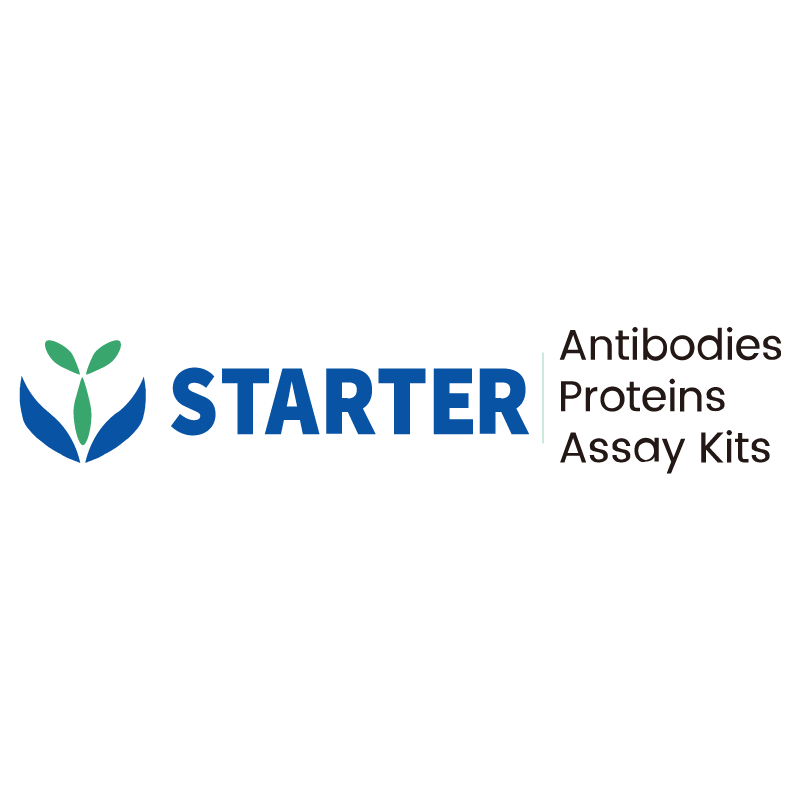WB result of DAZL Rabbit pAb
Primary antibody: DAZL Rabbit pAb at 1/1000 dilution
Lane 1: mouse testis lysate 20 µg
Secondary antibody: Goat Anti-rabbit IgG, (H+L), HRP conjugated at 1/10000 dilution
Predicted MW: 33 kDa
Observed MW: 38 kDa
Product Details
Product Details
Product Specification
| Host | Rabbit |
| Antigen | DAZL |
| Synonyms | Deleted in azoospermia-like; DAZ-like autosomal; Deleted in azoospermia-like 1; Dazl1; Dazla |
| Immunogen | Synthetic Peptide |
| Location | Cytoplasm |
| Accession | Q64368 |
| Isotype | IgG |
| Application | WB, IHC-P, IF, IP |
| Reactivity | Hu, Ms, Rt |
| Purification | Protein A |
| Concentration | 0.5 mg/ml |
| Conjugation | Unconjugated |
| Physical Appearance | Liquid |
| Storage Buffer | PBS, 40% Glycerol, 0.05% BSA, 0.03% Proclin 300 |
| Stability & Storage | 12 months from date of receipt / reconstitution, -20 °C as supplied |
Dilution
| application | dilution | species |
| WB | 1:1000 | |
| IP | 1:50 | |
| IHC-P | 1:250 | |
| IF | 1:250 |
Background
DAZL, or Deleted in Azoospermia-Like, is an RNA-binding protein that plays a pivotal role in germ cell development and oocyte maturation. It is specifically expressed in germ cells and is essential for their proper differentiation and function. DAZL has been shown to regulate the translation of a variety of mRNAs, thereby controlling the expression of proteins critical for germ cell development. Recent studies have revealed that DAZL can function as both a repressor and activator of mRNA translation, depending on the context and the specific mRNA targets. It interacts with the 3' untranslated regions (UTRs) of its target mRNAs, modulating their stability and translation efficiency. DAZL's dual role in translational control is significant for understanding the molecular mechanisms underlying germ cell maturation and early embryonic development. The protein's function is so critical that its absence or mutation can lead to infertility, as seen in certain cases of male azoospermia.
Picture
Picture
Western Blot
WB result of DAZL Rabbit pAb
Primary antibody: DAZL Rabbit pAb at 1/1000 dilution
Lane 1: rat testis lysate 20 µg
Secondary antibody: Goat Anti-rabbit IgG, (H+L), HRP conjugated at 1/10000 dilution
Predicted MW: 33 kDa
Observed MW: 38 kDa
IP
DAZL Rabbit pAb at 1/50 dilution (1 µg) immunoprecipitating DAZL in 0.4 mg mouse testis lysate.
Western blot was performed on the immunoprecipitate using DAZL Rabbit pAb at 1/1000 dilution.
Secondary antibody (HRP) for IP was used at 1/1000 dilution.
Lane 1: mouse testis lysate 20 µg (Input)
Lane 2: DAZL Rabbit pAb IP in mouse testis lysate
Lane 3: Rabbit monoclonal IgG IP in mouse testis lysate
Predicted MW: 33 kDa
Observed MW: 38 kDa
Immunohistochemistry
IHC shows positive staining in paraffin-embedded human testis. Anti-DAZL antibody was used at 1/250 dilution, followed by a HRP Polymer for Mouse & Rabbit IgG (ready to use). Counterstained with hematoxylin. Heat mediated antigen retrieval with Tris/EDTA buffer pH9.0 was performed before commencing with IHC staining protocol.
IHC shows positive staining in paraffin-embedded mouse testis. Anti-DAZL antibody was used at 1/250 dilution, followed by a HRP Polymer for Mouse & Rabbit IgG (ready to use). Counterstained with hematoxylin. Heat mediated antigen retrieval with Tris/EDTA buffer pH9.0 was performed before commencing with IHC staining protocol.
IHC shows positive staining in paraffin-embedded rat testis. Anti-DAZL antibody was used at 1/250 dilution, followed by a HRP Polymer for Mouse & Rabbit IgG (ready to use). Counterstained with hematoxylin. Heat mediated antigen retrieval with Tris/EDTA buffer pH9.0 was performed before commencing with IHC staining protocol.
Immunofluorescence
IF shows positive staining in paraffin-embedded mouse testis. Anti-DAZL antibody was used at 1/250 dilution (Green) and incubated overnight at 4°C. Goat polyclonal Antibody to Rabbit IgG - H&L (Alexa Fluor® 488) was used as secondary antibody at 1/1000 dilution. Counterstained with DAPI (Blue). Heat mediated antigen retrieval with EDTA buffer pH9.0 was performed before commencing with IF staining protocol.


